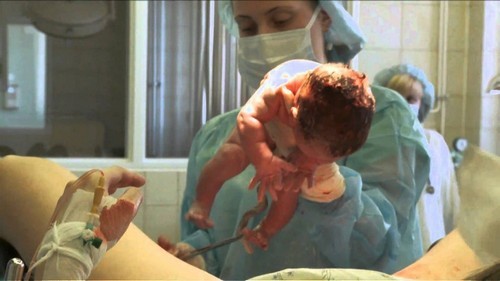However, many pregnant women often worry about the upcoming birth of the baby: what to do and how to breathe correctly during childbirth ?
Every future mother constantly listens to the movement of her baby in her stomach, knows whether the baby is sleeping or not, thinks lovingly about this little man inside her.
Pregnancy is a time of miracles, because women are incredibly lucky: she can create this little angel in herself.
Childbirth: part one. No panic!
Childbirth is always painful. But the degree of pain in everyone is different, so you do not need to wind up yourself and be nervous, thinking about the impending pain. It is better to wait the first bouts at home, because the native walls are better than the gray sick-list.
Take care of your affairs calmly, pass the time for your favorite pastime, keep your breathing steady so that the baby feels that everything is fine and there is no need to worry. During childbirth, both of you will experience severe stress, there’s no reason to bother the baby again. As soon as the contractions intensify, go to the maternity hospital.
Strengthening pain: help yourself!
Contractions become more frequent, the interval is reduced, does the pain intensify? Congratulations! Disclosure is in full swing. The most important thing is not to focus on the pain of childbirth and relax. Use the “anesthetic” breathing technique: slow inhalation and very slow exhalation between contractions, and sharp and short exhale breaths during uterine contractions. Relax, let yourself think that you, like a beautiful flower, open up, giving the world a new life.
During periods of calm, try to breathe so as to calm yourself. This is very important, because you are still pregnant, and worrying is strictly prohibited.

Attempts: the final is near!
Attempts are expelling contractions of the muscles of the uterus that occur arbitrarily and contribute to the process of giving birth to a baby.
Most often, a busy period begins when the disclosure has already been completed and the baby is ready to be born. By themselves, attempts are not distinguished by soreness, unpleasant sensations arise more likely from the fact that the baby’s head passes through the birth canal. You need to push only when the obstetrician is convinced that the head lies on the pelvic floor. Now the technique of proper breathing during childbirth should be fully observed: not only the child’s health, sometimes his life, depends on the speed of delivery. Remember: your child depends on your breathing! We need accurate, quick action. Listen to the obstetrician and follow all the requirements.
How and when to start pushing?
The need to push can occur at different times. It is necessary to wait until the obstetrician gives the go-ahead. If you start earlier, you can earn yourself a few cervical tears. A special breathing technique is recommended to restrain labor contractions during childbirth.
In order to expel the fetus, the woman in labor must give all her best. Smooth breath, we tighten the muscles of the press and gradually increase the pressure on the bottom, helping the baby to be born. Then a smooth exhale. The hips and buttocks are relaxed all the time! DO NOT exhale sharply, so as not to harm your child by a reduction in intrauterine pressure. After exhaling, immediately push again. For one fight, you need to have time to repeat the above three times. After the attempt is over, breathing is needed. Calm down, relax, relax. You need to breathe evenly to build up strength for the next fight.
It is very important to remember that when the midwife begins to withdraw the head, you need not to push! The breathing technique is a dog (short and rhythmic inhalation and exhalation). As soon as this happens, you can calm down: the main part of the path has been covered and the matter is small. There was the last effort to give birth to the shoulders of the baby.
So, during a tight fight, we strongly pull the chair handles towards us, and we rest our feet against the stand, as if pushing from it. Press your chin to your chest and in no case bring your legs together. Direct all the energy to the point where it hurts the most and try to push this point out of yourself. If the pain intensifies, then you are well done, and you are doing everything right, and your child is about to breathe air for the first time!
Nulliparous mothers experience attempts for about 2 hours; Many factors influence the duration, for example, the use of anesthesia during childbirth can stretch this process to three hours, which will not affect the baby’s condition very well. Therefore, it is best to refuse the introduction of painkillers, and learn how to breathe correctly to help yourself. Many factors significantly facilitate this time: if a mother has good muscles of the press, the birth process will be much easier. Before delivery, the ward should be well ventilated. Clean air invigorates and gives strength: some women in labor spend a very long time in the maternity ward.
Completion. Afterbirth.
As soon as the obstetrician gives the command to push for the appearance of the shoulders, we wait for the contractions and begin to repeat the breathing technique described above. As soon as the shoulders come out, the doctor will take your baby to the light, wash, wrap and help put it on your chest. Most likely, there will be no milk in it, but colostrum will be more than enough for him. Mom remembers these minutes for the rest of her life: this is happiness. What a mother experiences when she picks up her newborn child is worth all the torment on the birth chair. The highest happiness!

The last is the shell that protected the baby for nine long months.
If the placenta did not come out on its own right after the birth, you will have to “give birth” to it. Take air into the lungs and push again, as if you are continuing to give birth to a baby. For convenience, rest your feet on the stands or grab your knees with your hands, spreading your legs to the sides. You can breathe as comfortably. Now breathing is not so important.
Now the doctor will examine you for gaps, assess the condition of the uterus, if necessary, darn you. This is an unpleasant procedure, but you need to be patient. During childbirth, very large gaps could result, without suturing which you can sign yourself a sentence for complications and illnesses.
Gaps: is it possible to avoid the appearance?
The obstetrician protects the perineum from tears, helping the head to gradually pass through the birth canal, supporting it with three fingers. If you allow quick birth – 100% will be a gap. Accurate work of the obstetrician promotes the correct management of childbirth. Nature conceived the patency of the head through the vagina during an attempt, so the doctor’s task is to help a little, and to guide the unprepared woman in labor on the right path.
First, the nape of the baby appears, then the crown. The woman in labor stops pushing, and the doctor helps the face to be born. Do not forget that the integrity of the vagina and perineum also depends on the actions of the woman in labor.
The “dog” breathing technique helps smooth and weaken attempts. During the delivery of the head, it is turned back, then it is turned to the right or left side, and inside, after the head, the shoulders are turned. Only after a complete turn of the baby does the continuation of childbirth take place.
A rupture of the cervix occurs if attempts have begun with incomplete disclosure, and the woman in labor has pushed. This can be avoided by enduring an attempt, for this you need to breathe “dog” again. Usually, in preparation for childbirth, specialists show and talk about all the correct ways of breathing during childbirth. Do not skip classes, this is very useful information for you. To alleviate the condition of yourself and your child, you need to be able to breathe correctly.



